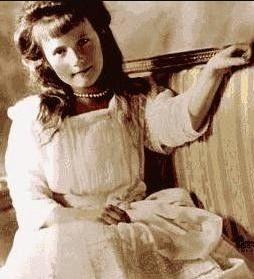Grand Duchess Anastasia Nikolaevna of Russia Death
Anastasia passed away on July 17, 1918 at the age of 17 in Yekaterinburg, Russia. Anastasia's cause of death was execution.
When did Grand Duchess Anastasia Nikolaevna of Russia die?
July 17, 1918How did Grand Duchess Anastasia Nikolaevna of Russia die? What was the cause of death?
ExecutionHow old was Grand Duchess Anastasia Nikolaevna of Russia when died?
17Where did Grand Duchess Anastasia Nikolaevna of Russia die? What was the location of death?
Yekaterinburg, Russia
Grand Duchess Anastasia Nikolaevna of Russia Birthday and Date of Death
Grand Duchess Anastasia Nikolaevna of Russia was born on June 18, 1901 and died on July 17, 1918. Anastasia was 17 years old at the time of death.
Birthday: June 18, 1901
Date of Death: July 17, 1918
Age at Death: 17
Is Grand Duchess Anastasia Nikolaevna of Russia's father, Nicholas II of Russia, dead or alive?
Nicholas II of Russia's information is not available now.
Is Grand Duchess Anastasia Nikolaevna of Russia's mother, Alexandra Feodorovna, dead or alive?
Alexandra Feodorovna's information is not available now.
Grand Duchess Anastasia Nikolaevna of Russia's sisters :
Anastasia has 3 sisters:Grand Duchess Anastasia Nikolaevna of Russia's sister, Grand Duchess Maria Nikolaevna of Russia, died on July 17, 1918 as he was 19 years old. His cause of death was executed.
- Grand Duchess Tatiana Nikolaevna of Russia
Grand Duchess Anastasia Nikolaevna of Russia's sister, Grand Duchess Olga Nikolaevna of Russia, died on July 17, 1918 as he was 22 years old. His cause of death was execution.
Grand Duchess Anastasia Nikolaevna of Russia's brothers :
Anastasia has 2 brothers:- Alexei Nikolaevich
- Tsarevich of Russia
Grand Duchess Anastasia Nikolaevna of Russia's pets, dead or alive?
- Shvybzik (Dog - Japanese Chin)
- Jimmy (Dog - King Charles Spaniel) [1917-1918]
- Kiki (Cat - white cat)
Grand Duchess Anastasia Nikolaevna of Russia - Biography
Grand Duchess Anastasia Nikolaevna of Russia was the youngest daughter of Tsar Nicholas II, the last sovereign of Imperial Russia, and his wife, Tsarina Alexandra Fyodorovna.
After the Bolshevik revolution in October 1917, Russia quickly disintegrated into civil war. Negotiations for the release of the Romanovs between their Bolshevik (commonly referred to as 'Reds') captors and their extended family, many of whom were prominent members of the royal houses of Europe, stalled. As the Whites (anti-Bolshevik forces, although not necessarily supportive of the Tsar) advanced toward Yekaterinburg, the Reds were in a precarious situation. The Reds knew Yekaterinburg would fall to the better manned and equipped White Army. When the Whites reached Yekaterinburg, the imperial family had simply disappeared. The most widely accepted account was that the family had been murdered. This was due to an investigation by White Army investigator Nicholas Sokolov, who came to the conclusion based on items that had belonged to the family being found thrown down a mine shaft at Ganina Yama.
The "Yurovsky Note", an account of the event filed by Yurovsky to his Bolshevik superiors following the killings, was found in 1989 and detailed in Edvard Radzinsky's 1992 book, The Last Tsar. According to the note, on the night of the deaths the family was awakened and told to dress. They were told they were being moved to a new location to ensure their safety in anticipation of the violence that might ensue when the White Army reached Yekaterinburg. Once dressed, the family and the small circle of servants who had remained with them were herded into a small room in the house's sub-basement and told to wait. Alexandra and Alexei sat in chairs provided by guards at the Empress's request. After several minutes, the guards entered the room, led by Yurovsky, who quickly informed the Tsar and his family that they were to be executed. The Tsar had time to say only "What?" and turn to his family before he was killed by several bullets to the chest (not, as is commonly stated, to the head; his skull, recovered in 1991, bears no bullet wounds). The Tsarina and her daughter Olga tried to make the sign of the cross, but were killed in the initial volley of bullets fired by the executioners. The rest of the Imperial retinue were shot in short order, with the exception of Anna Demidova, Alexandra's maid. Demidova survived the initial onslaught, but was quickly stabbed to death against the back wall of the basement, while trying to defend herself with a small pillow she had carried into the sub-basement that was filled with precious gems and jewels.
The "Yurovsky Note" further reported that once the thick smoke that had filled the room from so many weapons being fired in such close proximity cleared, it was discovered that the executioners' bullets had ricocheted off the corsets of two or three of the Grand Duchesses. The executioners later came to find out that this was because the family's crown jewels and diamonds had been sewn inside the linings of the corsets to hide them from their captors. The corsets thus served as a form of "armor" against the bullets. Anastasia and Maria were said to have crouched up against a wall, covering their heads in terror, until they were shot down by bullets, recalled Yurovsky. However, another guard, Peter Ermakov, told his wife that Anastasia had been finished off with bayonets. As the bodies were carried out, one or more of the girls cried out, and were clubbed on the back of the head, wrote Yurovsky.








